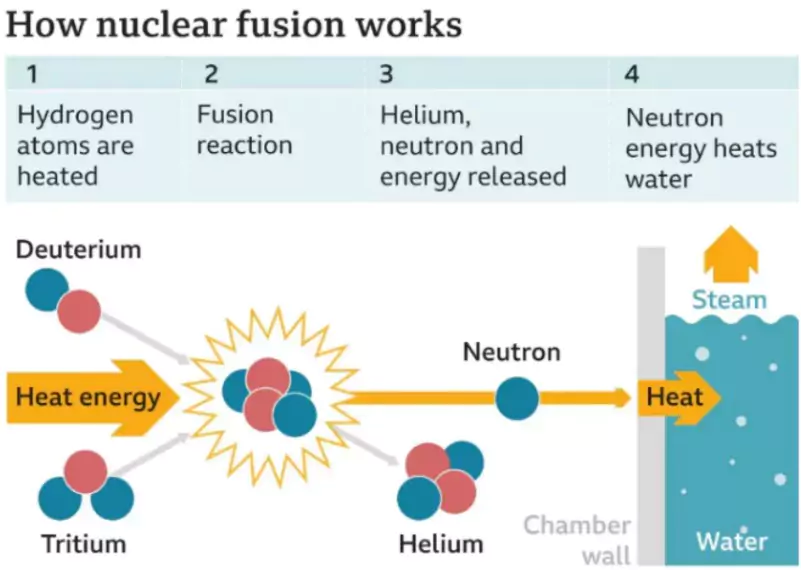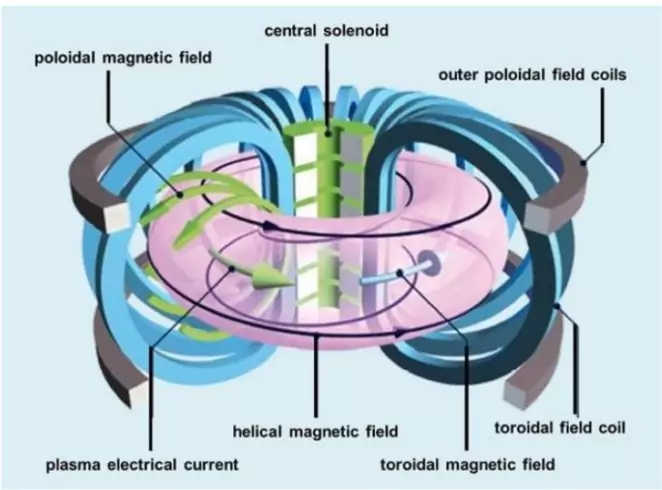Researchers at the Institute for Plasma Research (IPR), Gandhinagar, have proposed a roadmap for India’s fusion energy programme.
- The plan envisages building India’s first fusion–fission hybrid reactor, Steady-state Superconducting Tokamak-Bharat (SST-Bharat) as a step toward commissioning a full-scale demonstration fusion reactor by 2060.
About Nuclear Fusion

- Process: Fusion involves combining two light nuclei to form a heavier nucleus, releasing vast energy (e.g., energy source of stars).
- Conditions Required: Extreme temperature and pressure, similar to stellar interiors.
- Fission vs Fusion:
-
- Fission splits heavy atoms; produces significant radioactive waste.
- Fusion produces much less long-lived radioactive waste, making it more attractive.
Techniques of Fusion
- Inertial confinement: Using lasers/X-rays to compress fuel capsules.
- Magnetic confinement: Using strong magnetic fields to confine plasma at ~100 million °C.
- India participates in the International Thermonuclear Experimental Reactor (ITER) project, France, which uses magnetic confinement (tokamak design).
Challenges in Achieving Fusion Energy
- Extreme Temperature Requirements: Plasma must be heated and maintained at millions of degrees.
- Sustained Reaction: Plasma confinement for long periods is unstable.
- High Initial Costs: Research and reactor construction require billions of dollars.
- No Commercial Fusion Yet: Current fusion experiments do not yet generate electricity.
India’s Roadmap
- Steady-state Superconducting Tokamak-Bharat (SST-Bharat)
- Overview: The Institute for Plasma Research has proposed building the Steady-state Superconducting Tokamak-Bharat, which will function as a fusion–fission hybrid reactor.
- Output: It is expected to produce an output-to-input power ratio of 5, with 100 MW from fission and 30 MW from fusion.
- Estimated cost: ₹25,000 crore.
- Long-Term Goal: Commissioning of a demonstration reactor by 2060 with a power ratio (Q value) of 20, which is regarded as commercially viable, and a total output of 250 MW.
- Current Capability:
- SST-1 tokamak at IPR: It has sustained plasma for about 650 milliseconds and is designed to reach 16 minutes.
- Global Record: By contrast, the WEST tokamak in France set a global record in February 2025 by maintaining plasma for 22 minutes.
Tokamak

- Definition: Tokamak is a device that uses magnetic confinement to contain and control plasma for nuclear fusion.
- Design: Donut-shaped (toroidal) chamber lined with powerful superconducting magnets.
- Working:
-
- Plasma is heated to extreme temperatures (~100 million °C).
- Magnetic fields confine the plasma, preventing it from touching reactor walls.
- Fusion occurs when hydrogen isotopes (like deuterium & tritium) combine to form helium, releasing huge energy.
- Global Examples: ITER (France), EAST (China), WEST (France), SST – 1 (India)
|
Innovations Proposed
- Digital Twins: Researchers propose creating digital twins, which are virtual replicas of a tokamak that simulate real-time plasma behaviour and allow design testing before physical construction.
- Machine Learning Integration: Machine learning is suggested as a tool to assist in plasma confinement and predictive control, improving the stability of fusion reactions.
- Radiation-Resistant Materials: The roadmap stresses the need to develop materials capable of withstanding intense radiation in reactors, which will enhance durability and operational safety.
- Superconducting Magnets and Plasma Modelling: The development of advanced superconducting magnets and more sophisticated plasma modelling techniques is seen as essential for achieving efficiency and reliability in India’s fusion programme.
Global Comparisons
- ITER (France): The world’s largest magnetic confinement project aims for a Q value of 10.
- United Kingdom (STEP): The UK plans to demonstrate a prototype fusion plant by 2040.
- United States (Private Sector): Several private firms claim they will achieve grid-connected fusion by the 2030s.
- China (EAST Tokamak): China has already set records for plasma duration, reflecting rapid progress.
- India’s Timeline: India’s target of 2060 is more cautious and places it behind the global frontrunners, but it provides a long-term structured approach.
Challenges
- Technical Hurdles: Achieving plasma confinement for long durations and scaling up to commercial reactors remain difficult tasks.
- Economic Viability: The estimated cost of ₹25,000 crore and high R&D expenses pose major challenges, and fusion power’s affordability compared to other sources remains uncertain.
- Policy and Funding Constraints: India’s efforts are largely public-sector driven, with little private-sector participation, unlike the US and Europe where start-ups play a major role.
- Competition from Renewables: India’s commitments to net zero by 2070 prioritise solar, wind, and nuclear fission, which compete with fusion for funding and policy focus.
Strategic Value of Fusion R&D
- Technological Spin-offs: Research in fusion will yield advances in radiation-resistant materials, superconducting magnets, plasma modelling, and high-temperature engineering.
- Industrial Capacity: These developments can upgrade Indian industry, foster innovation, and strengthen technological autonomy.
- Global Partnerships: Participation in ITER and collaborations with international firms will bring project management expertise and innovation to Indian labs.
Way Forward
- Increased Investment: India must enhance funding for fusion research beyond current modest allocations.
- Private Sector Role: Greater involvement of private industry and start-ups is needed to complement public sector efforts.
- Global Collaboration: Partnerships with advanced programmes like STEP (UK) and EAST (China) can bring technology-sharing benefits.
- Focus on Materials & AI: Development of radiation-resistant materials, superconducting magnets, and use of digital twins with AI can address key technical bottlenecks.
- Policy Alignment: Fusion research should be integrated into India’s broader energy security and net-zero strategy to ensure complementarity with renewables and fission.
- Skill Development: Creation of specialised training and international fellowships is essential for building expertise in plasma physics, materials science, and nuclear safety.
![]() 24 Sep 2025
24 Sep 2025


